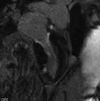Ischaemia as a cause of LVOT gradient reversal in HCM
- PMID: 28870983
- PMCID: PMC5633053
- DOI: 10.1530/ERP-17-0030
Ischaemia as a cause of LVOT gradient reversal in HCM
Abstract
We present the case of a previously fit 84-year-old female with long-standing systemic hypertension and the echo phenotype of hypertrophic cardiomyopathy (HCM) - asymmetrical septal hypertrophy, significant resting left ventricular (LV) outflow obstruction and mitral regurgitation (MR) secondary to systolic anterior motion (SAM) of the mitral valve. Valsalva provocation caused an increase in LVOT dynamic gradient and MR severity. The patient presented with a progressive decrease in exercise capacity along with chest pain relieved by rest or sublingual GTN. Exercise stress echo demonstrated a paradoxical response with reduction of both LVOT gradient and severity of MR. There was evidence of inducible regional wall motion abnormalities associated with no change in LV cavity size. Coronary angiogram revealed significant triple vessel disease.
Learning points: 20% of adult HCM patients over the age of 45 years have been shown to have coexistent coronary artery disease (CAD) that is associated with a reduced overall survival. Diagnosis of CAD in patients with HCM is difficult to make based on clinical grounds because of the high incidence of angina in patients with HCM but no CAD.Reduction of LVOT gradient with stress in patients with HCM (in the absence of a vaso-vagal response) may indicate ischaemia due to significant multivessel epicardial CAD, including left mainstem stenosis. Hence, this finding during stress echocardiography suggests that further investigation of the coronaries should be considered.Exercise stress echocardiography has not been validated for the assessment of ischaemia secondary to epicardial coronary disease in patients with HCM because ischaemia in this group of patients is often caused by multiple mechanisms, including microvascular ischaemia and myocardial bridging.Comparative assessment of rest and peak exercise 2D strain may add incremental value in identifying regional wall motion abnormalities, which may be difficult to distinguish by eye in hypertrophied, dynamic myocardium.A paradoxical response to exercise with significant decrease in LVOT obstruction and MR has been reported in the literature. This is often associated with a trend toward increased exercise capacity and better prognostic outcomes. Our clinical case presents a significant decrease in LVOT obstruction and MR that was associated with a trend toward reduced exercise capacity and was caused by ischaemia.
Keywords: HCM; LVOT obstruction; ischaemia in HCM; paradoxical LVOT obstruction.
© 2017 The authors.
Figures
Similar articles
-
Routine orthostatic LVOT gradient assessment in patients with basal septal hypertrophy and LVOT flow acceleration at rest: please stand up.Echo Res Pract. 2019 Mar 1;6(1):K1-K6. doi: 10.1530/ERP-18-0072. Echo Res Pract. 2019. PMID: 30668520 Free PMC article.
-
Paradoxical response to exercise in asymptomatic hypertrophic cardiomyopathy: a new description of outflow tract obstruction dynamics.J Am Coll Cardiol. 2013 Aug 27;62(9):842-50. doi: 10.1016/j.jacc.2013.06.007. Epub 2013 Jun 27. J Am Coll Cardiol. 2013. PMID: 23810875
-
Echocardiographic and clinical outcomes of patients undergoing septal myectomy plus anterior mitral leaflet extension for hypertrophic cardiomyopathy.Rev Cardiovasc Med. 2021 Sep 24;22(3):983-990. doi: 10.31083/j.rcm2203107. Rev Cardiovasc Med. 2021. PMID: 34565099
-
Systolic anterior motion of the mitral valve in hypertrophic cardiomyopathy: a narrative review.J Thorac Dis. 2022 Jun;14(6):2309-2325. doi: 10.21037/jtd-22-182. J Thorac Dis. 2022. PMID: 35813751 Free PMC article. Review.
-
A systematic review and pooled analysis of septal myectomy and edge-to-edge mitral valve repair in obstructive hypertrophic cardiomyopathy.Rev Cardiovasc Med. 2021 Dec 22;22(4):1471-1477. doi: 10.31083/j.rcm2204151. Rev Cardiovasc Med. 2021. PMID: 34957786
References
-
- Smith N, Steeds R, Masani N, Sandoval J, Wharton G, Allen J, Chambers J, Jones R, Lloyd G, Rana B, et al. 2015. A systematic approach to echocardiography in hypertrophic cardiomyopathy: a guideline protocol from the British Society of Echocardiography. Echo Research and Practice 2 G1–G7. (10.1530/ERP-14-0115) - DOI - PMC - PubMed
-
- Baltabaeva A, Marciniak M, Bijnens B, Moggridge J, He FJ, Antonios TF, MacGregor GA, Sutherland GR. 2008. Regional left ventricular deformation and geometry analysis provides insights in myocardial remodeling in mild to moderate hypertension. European Journal of Echocardiography 9 501–508. (10.1016/j.euje.2007.08.004) - DOI - PubMed
-
- Raphael CE, Cooper R, Parker KH, Collinson J, Vassiliou V, Pennell DJ, de Silva R, Hsu LY, Greve AM, Nijjer S, et al. 2016. Mechanisms of myocardial ischemia in hypertrophic cardiomyopathy, insights from wave intensity analysis and magnetic resonance. Journal of the American College of Cardiology 68 1651–1660. (10.1016/j.jacc.2016.07.751) - DOI - PMC - PubMed
Publication types
LinkOut - more resources
Full Text Sources
Other Literature Sources
Miscellaneous


